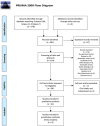Association between duration of breastfeeding and malocclusions in primary and mixed dentition: a systematic review and meta-analysis
- PMID: 28698555
- PMCID: PMC5505989
- DOI: 10.1038/s41598-017-05393-y
Association between duration of breastfeeding and malocclusions in primary and mixed dentition: a systematic review and meta-analysis
Abstract
The aim of this systematic review and meta-analysis was to examine the current evidence on the possible effects of breastfeeding on different malocclusion traits in primary and mixed dentition. A systematic search was made in three databases, using terms related to breastfeeding and malocclusion in primary and mixed dentition. Of the 31 articles that met the inclusion criteria and were included in the qualitative analysis, nine were included in the quantitative analysis. The quality of the 31 observational studies was moderate to high on the Newcastle-Ottawa Scale. It was found that the odds ratio for the risk of posterior crossbite was 3.76 (95% CI 2.01-7.03) on comparing children who had not been breastfed, with those breastfed for over six months, and rose to 8.78 (95% CI 1.67-46.1) when those not breastfed were compared to those breastfed for over twelve months. The odds ratio for class II malocclusion in children breastfed for up to six months compared to those breastfed for over six months was 1.25 (95% CI 1.01-1.55). Lastly, children who were breastfed for up to six months had an odds ratio of 1.73 (95% CI 1.35-2.22) for non-spaced dentition compared to those who were breastfed for over six months.
Conflict of interest statement
The authors declare that they have no competing interests.
Figures







Comment in
-
Breastfeeding and occlusal development.Evid Based Dent. 2018 Mar 23;19(1):5. doi: 10.1038/sj.ebd.6401282. Evid Based Dent. 2018. PMID: 29568028
References
-
- World Health Organization (WHO). 10 Facts on Breastfeeding. WHO [Internet]. [cited September 2016] Available in: http://www.who.int/features/factfiles/breastfeeding/en/ (2015).
Publication types
MeSH terms
LinkOut - more resources
Full Text Sources
Other Literature Sources
Medical
Miscellaneous

